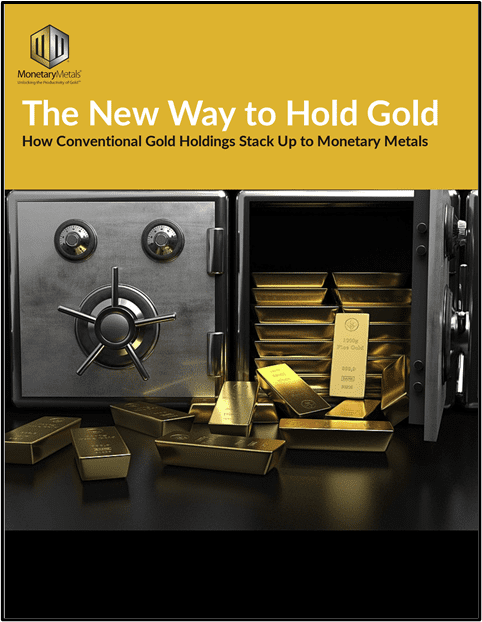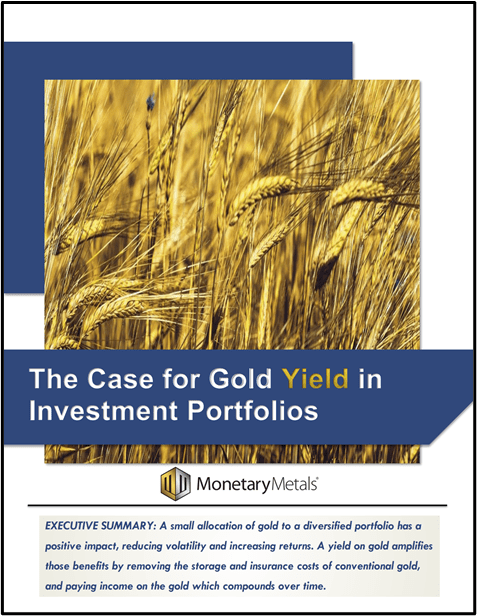Gold Bonds: Averting Financial Armageddon
After the near-collapse of the financial system in 2008, a growing number of people have come to realize that our monetary disease is terminal. It is that group to whom I address this paper. I sincerely hope that this group includes leaders in business, finance, and government.
I do not believe that my proposal herein is necessarily “realistic” (i.e. pragmatic). There are many interest groups that may oppose it for various reasons, based on their short-sighted desire to try to continue the status quo yet a while longer. Nevertheless, I feel that I must write and publish this paper. To say nothing in the face of the greatest financial calamity would go against everything I believe.
It seems self-evident. The government can debase the currency and thereby be able to pay off its astronomical debt in cheaper dollars. But as I will explain below, things don’t work that way. In order to use the debasement of paper currencies to repay the debt more easily, governments will need to issue and use the gold bond.
I give credit for the basic idea of using gold bonds to solve the debt problem to Professor Antal Fekete, as proposed in his paper: Cut the Gordian Knot: Resurrect the Latin Monetary Union. My paper covers different ground than Fekete’s, and my proposal is different as well. I encourage readers to read both papers.
The paper currencies will not survive too much longer. Most governments now owe as much or more than the annual GDPs of their nations (typically far more, under GAAP accounting). But the total liabilities in the system are much larger.
Even worse, in the formal and shadow banking system, derivative exposure is estimated to be more than 700 trillion dollars. Many are quick to insist that this is the “gross” exposure, and the “net” is much smaller as these positions are typically hedged. But the real exposure is close to the “gross” exposure in a crisis. While each party may be “hedged” by having a long leg and a balancing short leg, these will not “net out”. This is because in times of stress the bid (but not the offer) is withdrawn. To close the long leg of an arbitrage, one must sell on the bid (which could be zero). To close the short leg, one must buy at the offer (which will still be high). When the bid-ask spread widens that way, it will be for good reason and it does not do to be an armchair philosopher and argue that it “should not” occur. Lots of things will occur that should not occur.
For example, gold should not go into backwardation. This is another big (if not widely appreciated) piece of evidence that confidence in the ability of debtors to pay is waning. Gold and silver went into backwardation in 2008 and have been flitting in and out of backwardation since then. Backwardation develops when traders refuse to take a “risk free” profit. That is, the trade is free from all risks except the risk of default and losing one’s metal in exchange for a defaulted futures contract. See my paper When Gold Backwardation Becomes Permanent for a full treatment of this topic.
The root cause of our monetary disease has its origins in the creation of the Fed and other central banks prior to World War I, and in the insane treaty signed in 1944 at Bretton Woods in which many nations agreed for their central banks to use the US dollar as if it were gold, and this paved the way for President Nixon to pound in the final nail in the coffin. He repudiated the gold obligations of the US government in 1971, thereby plunging the whole world into the regime of irredeemable paper.
The US dollar game is a check-kiting scheme. The Fed issues the dollar, which is its liability. The Fed buys the US Treasury bond, which is the asset to balance the liability. The only problem is that the bonds are payable only in the central bank’s paper scrip! Meanwhile, per Bretton Woods, the rest of the world’s central banks use the dollar as if it were gold. It is their reserve asset, and they pyramid credit in their local currencies on top of it.
It is not a bug, but a feature, that debt in this system must grow exponentially. There is no ultimate extinguisher of debt. In my paper on Inflation, I define inflation as an expansion of counterfeit credit. I define deflation as a forcible contraction of counterfeit credit, and the inevitable consequence of inflation. Well, we have had many decades of rampant expansion of counterfeit credit. Now we will have deflation, and the harder the central banks try to fight it by forcing yet more expansion of counterfeit credit, the worse the problem becomes. With leverage everywhere in the system, it would not take many defaults to wipe out every financial institution. And there will be many defaults. One default will beget another and once it really begins in earnest there will be no stopping the cascade.
Another key problem is duration mismatch. Today, every bank and financial institution borrows short to lend long, many corporations borrow short to finance long-term projects, and every government is borrowing short to fund perpetual debts. Duration mismatch can cause runs on the banks and market crashes, because when depositors demand their money, banks must desperately sell any asset they can into a market that is suddenly “no bid”. In two papers (Fractional Reserve is Not the Problem and Falling Interest Rates and Duration Mismatch), I cover duration mismatch in banks and corporations in more depth.
Most banks and economists have supported a policy of falling interest rates since they began to fall in 1981. But falling interest rates destroy capital, as I explain in that last paper, linked above. As the rate of interest falls, the real burden of the debt, incurred at higher rates, increases.
Related to this phenomenon is the fact that the average duration of bonds at every level has been falling for a long time (US Treasury duration began increasing post 2008, but I think this is an artifact of the Fed’s purchases in their so-called “Quantitative Easing”). Declining duration is an inevitable consequence of the need to constantly “roll” debts. Debts are never repaid, the debtor merely pays the interest and rolls the principal when due. As the duration gets shorter and shorter, the noose gets tighter and tighter. If there is to be a real payback of debt, even in nominal terms, we need to buy more time. At the US Treasury level, average duration is about 5 years. I doubt that’s long enough.
And of course the motivation for building this broken system in the first place is the desire by nearly everyone to have a welfare state, without the corresponding crippling taxation. It has been long believed by most people a central bank is just the right kind of magic to let one have this cake and eat it too, without consequences. Well, the consequences are now becoming visible. See my papers The Laffer Curve and Austrian Economics and A Politically Incorrect Look at Marginal Tax Rates discussing what raising taxes will do, especially in the bust phase like we have now.
In reality, stripped of the fancy nomenclature and the abstraction of a monetary system, the picture is as simple as it is bleak. Normally, people produce more than they consume. They save. A frontier farmer in the 19th century, for example, would dedicate some work to clearing a new field, or building a smokehouse, or putting a wall around a pasture so he could add to his herd. But for the past several decades, people have been tricked by distorted price signals (including bond prices, i.e. interest rates) into consuming more than they produce.
In any case, it is not possible to save in an irredeemable paper currency. Depositing money in a bank will just result in more buying of government bonds. Capital accumulation has long since turned to capital decumulation.
This would be bad enough, as capital is the leverage on human effort that allows us to have the present standard of living. We don’t work any harder than early people did 10,000 years ago, and yet we are vastly more productive due to our accumulated capital.
Now much of the capital is gone, and it cannot be brought back. It will soon be impossible to continue to paper over the losses. The purpose of this piece is not to propose how to save the dollar or the other paper currencies. They are past the point where saving them is possible. This paper is directed to avoiding the collapse of our civilization.
If we stay on the present course, I think the outcome will look more like 472 AD than 1929. We must solve three problems to avoid that kind of collapse:
- Repayment of all debts in nominal terms
- Keep bank accounts, pensions, annuities, corporate payrolls, annuities, etc. solvent, in nominal terms
- Begin circulation of a proper currency before the collapse of the paper currencies, so that people have something they can use when paper no longer works
I propose a few simple steps first, and then a simple solution. All of this is designed to get gold to circulate once again as money. Today, we have gold “souvenir coins”. They are readily available, and have been for many years, but they do not circulate.
A gold standard is like a living organism. While having the right elements present and arranged in the right way is necessary, it is not sufficient. It must also be in constant motion. Gold, under the gold standard, was always flowing. Once the motion is stopped, restarting it is not easy. This applies to a corpse of a man as well as of a gold standard.
The first steps are:
- Eliminate all capital “gains” taxes on gold and silver
- Repeal all legal tender laws that force creditors to accept paper
- Also repeal laws that nullify gold clauses in contracts
- Open the mint to the (seigniorage) free coinage of gold and silver; let people bring in their metal and receive back an equal amount in coin form. These coins should not be denominated in paper currency units, but merely ounces or grams
Each of these items removes one obstacle for gold to circulate as money, along side the paper currencies. The capital “gains” tax will do its worst damage precisely when people need gold the most. At that point, the nominal price of gold in the paper currencies will be rising very rapidly. Any sale of bullion will result in a tax of virtually the entire amount, as the cost basis from even a few weeks prior will be much lower than the current price. This amounts, in the US, to a 28% confiscation of gold. This tax will force people to keep gold underground and not bring it to market. It will contribute to the acceleration of permanent backwardation.
It is important to realize that gold is not “going up”. Paper is going down. There is no gain for the holder of gold; he has simply not lost wealth due to the debasement of paper.
Current law forces creditors to accept paper as payment in full for all debts, and there are also laws that nullify gold clauses in contracts. Repeal them, and let creditors and borrowers negotiate something mutually agreeable.
Finally, the bid-ask spread on gold bullion coins such as the US gold eagle or the South African krugerrand is too wide. If the mint provided seigniorage-free coinage service, then people would bring in gold bars and other forms of bullion until the bid-ask spread narrowed appropriately. One of the attributes that gives gold its “moneyness” is its tight spread (even today, it is 10 to 30 cents per $1600 ounce!) But currently, this tight spread only applies to large bullion bars traded by the bullion banks and other sophisticated traders. This spread must be available to the average person.
As I said earlier, these steps are necessary. Gold certainly will not circulate under the current leftover regime from Roosevelt and Nixon. But it is not sufficient to address the debt problem.
Accordingly, I propose a simple additional step. The government should sell gold bonds. By this, I do not mean gold “backed” paper bonds. I mean bonds denominated in ounces of gold, which pay their coupon in ounces of gold and pay the principal amount in ounces of gold. Below, I explain how this will solve the three problems I described above.
Mechanically, it is straightforward. The government should set a rule that, to buy a gold bond, one does not bid dollars. One bids paper bonds! So to buy a 100-ounce gold bond, then one could bid for example $160,000 worth of paper bonds (assuming the price of gold is $1600 per ounce). The government retires the paper bond and in exchange replaces it with a newly-issued gold bond.
The government should start with a small tender, to ensure a high bid to cover ratio. And a series of small auctions will give the market time to accept the idea. It will also allow the development of gold bond market makers.
With gold bonds, it would be possible to sell long durations. With paper, there is no good reason to buy a 30-year bond (except to speculate on the next move by the central bank). The dollar is expected to fall considerably over a 30-year period. But with gold, there is no such debasement. The government could therefore exchange short-duration debt for long-duration debt.
At first, the price of the gold bonds would likely be set as a straight conversion of the gold price, perhaps adjusted for differing durations. For example, a 100 ounce gold bond of 30 years duration might be bid at $160,000 worth of 30-year paper bond.
But I think that the bid on gold bonds will rise far above “par”, for several reasons I will discuss below.
The nature of the dynamic will become clear to more and more people in due course. In the present regime, there is a common misconception that the yield on a bond is set by the market’s expectation of how much consumer prices will rise (the crude proxy for the loss of value for the dollar). But this is not true. Unlike in a gold standard, in an irredeemable paper standard, people are disenfranchised. They have no say over the rate of interest. The dollar system is a closed loop, and if you sell a bond then you either hold cash in a bank, which means the bank will buy a bond. Or you buy another asset. In which case the seller of that asset holds cash in a bank or buys a bond. This is one of the reasons why the rate of interest has been falling for 30 years despite huge debasement. All dollars eventually go into the Treasury bond.
The price of the paper bond today is set by a combination of central bank buying, and structural distortions in the system. But it is a self-referential price, in a game between the Treasury and the Fed. The price of the bond does not really come from the market. And this impacts every other bond in the universe, which all trade at varying spreads to the Treasury.
An alternative to paper bonds would be very attractive to those who want to save and earn income for the long term, pension funds, annuities, etc. Not only will the price of gold continue to rise (i.e. the value of the paper currency will continue to fall towards zero), but also a premium for gold bonds would develop and grow. The quality asset will be recognized to be worth more, and at the least people would price in whatever rate of the price of gold they expect to occur over the duration of the bond.
This dynamic—a rising price of gold, and a rising exchange value of gold bonds for paper bonds—will allow governments and other debtors to use the devaluation of paper as a means to repay their debts in nominal terms, but affordably in real terms.
This is impossible under paper bonds! This is because the process of debasement is a process of the Treasury borrowing more money. Debt goes up to debase the dollar. This path leads not to repayment of the debt cheaply, but to exponentially growing debt until a total default.
So we have solved problem number one. With a rising gold price, and a rising exchange rate of gold bonds for paper bonds, we have set up a dynamic whereby every paper obligation can be met in nominal terms. Of course, the value of that paper will be vastly lower than it is today. This is the only way that the immense amounts of debt outstanding can possibly be honored.
This also solves problem number two. If every financial institution is repaid every nominal dollar it is owed, then they will remain solvent. To be sure, pension payments, bank accounts, corporate payroll, and annuities etc. will be of much lower real value. But there is a critical difference between smoothly losing value vs. abruptly losing everything, along with catastrophic failure of the financial system.
I want to address what could be a misconception at this point. Does this work only for governments that have gold reserves in the vaults? No, this is not about gold reserves. While that may help accelerate a gold bond program, the essential is not gold stocks but gold flows. The government issuer of gold bonds must have a gold income (or a credible plan to develop one quickly).
And this leads to problem number three. Gold does not circulate today. Who has a gold income? That is where we must look to begin the loop. There is one kind of participant today who has a gold income: the gold miner. Beset by environmentalist lawsuits, regulations, permits, impact studies, fees, labor law, confiscatory taxes, and other obstacles created by government, these companies still manage to extract gold out of the ground.
The gold miners are the group to which we must turn to help solve the catch-22 of getting gold to circulate from the current state where it does not. I think there is a simple win-win proposition to offer them. In exchange for exemptions from the various taxes, regulations, environmentalism, etc. they have a choice to pay a tax in gold bullion.
There are other kinds of entities to consider taxing, but the problem is that they all would need to buy gold in the open market in order to pay the tax. As the price begins to rise exponentially, this will be certain bankruptcy for anyone but a gold miner.
And now, look at the progress we’ve made on the problem of getting gold to circulate. We have gold miners paying tax in gold to governments who are making bond coupon payments in gold to investors who now have a gold income. We can see how gold bond market makers will enter the scene, and earn a gold income to provide liquidity for bonds that are not “on the run”. These bond market makers could pay a tax in gold also.
And we have released other creditors from any restriction in lending and demanding repayment in gold. And anyone else in a position to sign a long-term agreement involving a stream of payments over a long period of time, such as landlords, can incorporate gold clauses in their contracts. And if the tenant has a gold income, perhaps from owning a gold bond, he can manage his cash flows and confidently sign such a lease.
Note that the lender, unlike the employee, the restaurant, or most other economic actors, is in a position to demand gold. While everyone else would like to be paid in gold, they haven’t got the pricing power to demand it. The lender can say: “if you want my capital, you must repay it in gold!”
If enough gold bonds are issued soon enough, we may reverse the one-way flow of gold from the markets into private hiding, that is inexorably leading to inevitable permanent backwardation and the withdrawal of all gold from the system.
One of the key points in my backwardation paper is that the value of the dollar collapses to zero not as a consequence of the quantity of dollars rising to infinity, but because of the desire of some dollar holders to get gold. If they cannot trade paper for gold, then they will trade paper for commodities without regard to price and trade those commodities for gold. This will cause the price of the commodities in dollar terms to rise to levels that make the dollar useless in trade (and collapse the price of commodities in gold terms).
If we reverse the flow of gold out of the markets, we may be able to prevent this disaster from occurring. The dollar will then continue to lose value in a continuous (if accelerating) manner, as people migrate to gold.
This is the best outcome that could possibly be hoped for. If it occurs along with a reduction in spending so that spending does not exceed (tax) revenues, we will avert Armageddon and be on the path to a proper and real recovery. To be clear, times will be hard and the average standard of living will decline precipitously.
But this is infinitely preferable to total collapse.
It is now up to farsighted leaders, especially in government, to take the first concrete steps towards saving Western Civilization.
Additional Resources for Earning Interest on Gold
If you’d like to learn more about how to earn interest on gold with Monetary Metals, check out the following resources:
In this paper we look at how conventional gold holdings stack up to Monetary Metals Investments, which offer a Yield on Gold, Paid in Gold®. We compare retail coins, vault storage, the popular ETF – GLD, and mining stocks against Monetary Metals’ True Gold Leases.
The Case for Gold Yield in Investment Portfolios
Adding gold to a diversified portfolio of assets reduces volatility and increases returns. But how much and what about the ongoing costs? What changes when gold pays a yield? This paper answers those questions using data going back to 1972.









Trackbacks & Pingbacks
[…] Article – Gold Bonds: Averting Financial Armageddon […]
[…] can use the gold bond to get out of debt at a discount (and a sovereign government debtor can use the gold bond to avert Armageddon). When it sells the new gold bond, the debtor should use the opportunity to retire its existing […]
[…] can use the gold bond to get out of debt at a discount (and a sovereign government debtor can use the gold bond to avert Armageddon). When it sells the new gold bond, the debtor should use the opportunity to retire its existing […]
[…] can use the gold bond to get out of debt at a discount (and a sovereign government debtor can use the gold bond to avert Armageddon). When it sells the new gold bond, the debtor should use the opportunity to retire its existing […]
[…] can use the gold bond to get out of debt at a discount (and a sovereign government debtor can use the gold bond to avert Armageddon). When it sells the new gold bond, the debtor should use the opportunity to retire its existing […]
[…] objective of my writing is to try to prevent it from happening. We need a graceful transition to gold, not an abrupt collapse like 476AD. It may be too late for the hapless Japanese. I hope […]
[…] plan to publish a separate paper revisiting my Gold Bonds to Avert Financial Armageddon thesis in light of the Swiss crisis. I will save for that paper my assessment of whether or how […]
[…] by offering my advice to the SNB. It is time to consider what would have been unthinkable. Issue gold bonds and begin the transition to the gold standard. I don’t think there is much time to […]
[…] propose gold bonds as the only way […]
Лучшие фильмы!
Смотрите фильмы лидеры проката
Comments are closed.